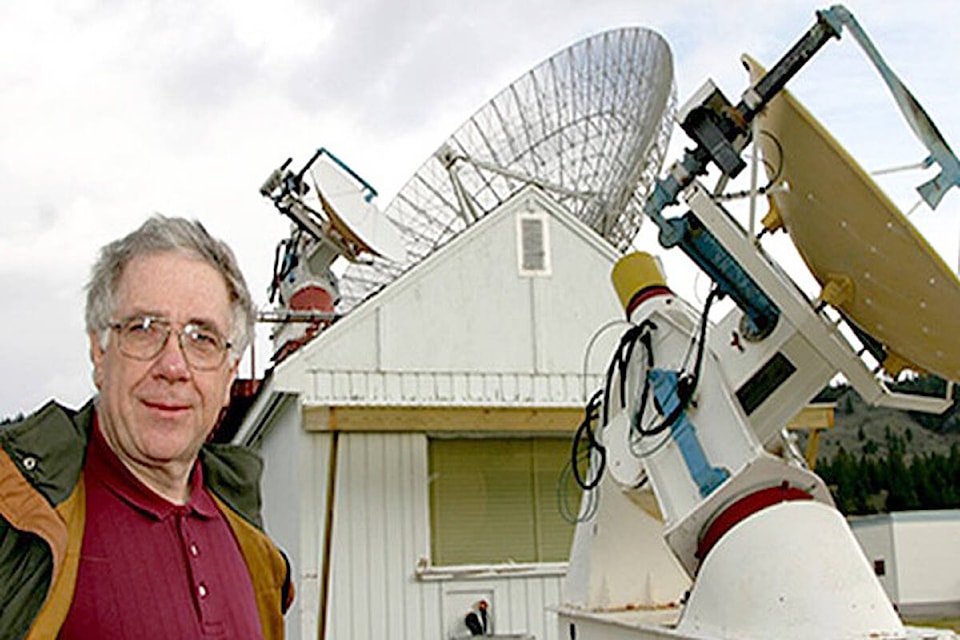The Nanaimo Astronomy Society’s next guest speaker became a radio astronomer the day he converted an old marine radar system into a radio telescope.
At a meeting Thursday, Oct. 28, Ken Tapping, astronomer with the National Research Council’s Dominion Radio Astrophysical Observatory near Penticton, will discuss solar storms, Earth’s atmospheric temperature and how solar weather can even affect space exploration.
Tapping, from Kent, England, was a teen in the early 1960s when he was first nudged toward astronomy by the BBC seven-episode science fiction series A for Andromeda. He was also curious about a new radio telescope in northern England.
Soon afterward, a friend connected Tapping with an engineer at a company that maintained shipboard radar systems. Tapping visited the engineer and was handed a box containing the transmitter and receiver for a Cossor Marine Radar system. He lugged the box home on a bus and his father helped retrieve the rest of the system – which included more components and a mounting rack – in his van.
“My parents were hugely tolerant,” Tapping said. “I got this thing running … and it was interfering with televisions and everything else, so I was getting dirty looks from my parents. The thing was just propped up in the backyard and there were cables running up the wall into my bedroom.”
One day Tapping hit on the idea of turning off the radar transmitter and simply watched the signal strength change as the Sun passed over the antenna dish.
“That day I became a radio astronomer,” he said.
But Tapping never thought he’d actually become a professional radio astronomer until he answered an ad in Wireless World magazine for engineers and scientists to work at a new radio telescope in Chilbolton, England. Tapping interviewed and got the job.
“So then I was developing radio telescope systems and doing some observations myself and it was wonderful,” he said.
While at Chilbolton, Tapping worked on a joint Canadian-U.K. project that linked radio telescopes thousands of kilometres apart to generate the resolving power needed to measure diameters of quasars and other distant objects. Contacts he made with Canadian astronomers prompted him to join Canada’s National Research Council in 1975 at the Algonquin Radio Observatory in Ontario. He became head of the solar monitoring program in 1985 and in 1990 he moved to the DRAO in B.C. and presided over next-generation solar flux monitor installation.
Solar research has led him to question such as how Earth was able to maintain liquid oceans when the sun was much dimmer.
“Life appeared on the Earth about 3.5 billion years ago, give or take. The sun was about 40 per cent fainter than it is now, so how come there were liquid oceans?” Tapping said. “The current feeling in science is the greenhouse effect in the atmosphere was much stronger than it is now because the atmosphere contained no oxygen.”
Earth’s ancient methane- and carbon dioxide-rich atmosphere trapped enough heat for liquid oceans and for life to start, he said, and plants cleaned out atmospheric carbon dioxide from the atmosphere and liberated oxygen and the oxygen helped clear the methane. The sun’s increasing brightness coincided with Earth’s atmospheric changes and decreasing greenhouse effect.
“Which I think is an absolutely fascinating part of the sun-Earth relationship … I think we’re in the process of damaging the mechanism that does that,” Tapping said.
Solar flares that happen to erupt in Earth’s direction might have had little impact other than to create aurora borealis in ancient times, but large flares definitely impact modern infrastructure, he said.
“Worldwide communications, large networks, power distribution, the internet, transportation and so on. This has brought us into a position where we’re increasingly vulnerable to the sun,” Tapping said. “For example, a solar flare can produce a lot of X-rays, the X-rays interfere with the ionosphere and the result is radio communications vanish.”
Tapping will engage his audience with facts and anecdotes about the relationship between the sun and Earth in his presentation during Nanaimo Astronomy Society’s meeting Thursday, Oct. 28, at 7 p.m.
Due to the COVID-19 pandemic, society meetings are being held online for paid members only, but non-members can attend one meeting for free. For more information about the society, visit www.nanaimoastronomy.com.
photos@nanaimobulletin.com
Like us on Facebook and follow us on Twitter
